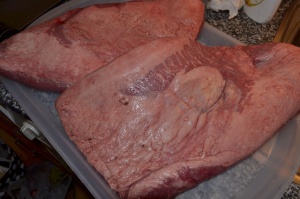rikun
Full Fledged Farker
I've cooked around 80+ flats (packers are really hard to find here overseas) and few packers I scored one time... Some have been awesome, some okay and some bland. Most of them I've more or less overcooked, since I've been waiting them to probe like buttah...
I usually cook them hot and fast at about 325, about four hours smoke and then foil. When I think they are done, I pull them, vent for about 10-15 minutes to stop carry over cooking and then FTC for 2-3 hours depending on schedule.
I still don't get the probe feel, either my flats are never going to be probe tender, or I'm taking the whole warm butter thing too literally.
Should I probe all the way to the bottom of the flat or just to the center? I always get some resistance when I probe deep (ahem), but there is no resistance 2/3 the way in. There might be some areas on the flat that have some resistance, but they are usually not in the thickest part. Or should I probe from the side?
And sometimes, like today, there was one flat that had no resistance anywhere and I was pretty certain it was done. It finished way earlier than the other ones and it was pretty spot on... I guess the other ones could have been done at the same time, but they didn't really feel like it at all...
With pork butts I really understand the concept, since they always feel very much like probing warm butter, really tender.
I'm probing with my Thermapen, not paying any attention to the reading, but I seldom pull before 210. I think I might have better luck pulling everything at 203-205 than continuing doing what I've been doing for now...
I usually cook them hot and fast at about 325, about four hours smoke and then foil. When I think they are done, I pull them, vent for about 10-15 minutes to stop carry over cooking and then FTC for 2-3 hours depending on schedule.
I still don't get the probe feel, either my flats are never going to be probe tender, or I'm taking the whole warm butter thing too literally.
Should I probe all the way to the bottom of the flat or just to the center? I always get some resistance when I probe deep (ahem), but there is no resistance 2/3 the way in. There might be some areas on the flat that have some resistance, but they are usually not in the thickest part. Or should I probe from the side?
And sometimes, like today, there was one flat that had no resistance anywhere and I was pretty certain it was done. It finished way earlier than the other ones and it was pretty spot on... I guess the other ones could have been done at the same time, but they didn't really feel like it at all...
With pork butts I really understand the concept, since they always feel very much like probing warm butter, really tender.
I'm probing with my Thermapen, not paying any attention to the reading, but I seldom pull before 210. I think I might have better luck pulling everything at 203-205 than continuing doing what I've been doing for now...



